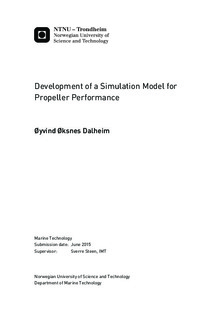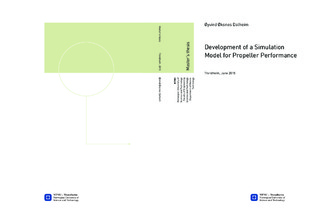| dc.description.abstract | The simulation model PropSiM for simulation of propeller performance has been developed and implemented into Simulink. The simulation model generates a time domain solution to the six degree of freedom propeller forces in varying operation conditions, including:
Change of operating point, including controllable pitch.
Unsteady axial and tangential inflow wake field.
Effect of oblique inflow in manoeuvring conditions.
Reduced propeller submergence.
Wagner effect.
Propeller ventilation.
The basic hydrodynamic propeller calculations are performed using propeller vortex lattice lifting line theory. The control and vortex points are cosine spaced along the lifting line, providing efficient convergence even for a limited number of vortex panels.
Solution to the unsteady inflow wake field is found using a quasi-steady approach, where calculations from all the respective blade positions are superimposed to get a representation of the unsteady wake field. This approach has been verified using simulations with the software AKPA.
The effect of oblique inflow is found by adapting the inflow wake field to the inflow an- gle and perform a skewed propeller wake correction. The effect of partly submergence is treated by forcing the circulation to be zero at the dry parts of the blade. In addition the Wagner effect is included. Ventilation is considered using an analogy to a blade experiencing only static pressure on the pressure side and atmospheric pressure on the suction side, and adding a weight factor for the amount of ventilated propeller disk area.
Comparison of open water test of the model scale KVLCC2 propeller, AKPA and PropSiM calculations shows that the predicted thrust and torque values generally are conservative. Yet the development with varying advance number J agrees well with the experiments. In addition the ability to reproduce an accurate spanwise circulation and lift distribution has been validated against akpa calculations. In general PropSiM overestimates the lift, but multiple runs indicate that the lift and circulation distribution are reproduced sufficiently for a wide range of operating points.
The simulation model has been validated against experimental results for four different cases of varying propeller submergence and ventilation mechanisms. The first case is a non-ventilating condition of a propeller being forced in sinusoidal heave motion. The other three cases are all ventilating conditions, while the last two cases are in addition surface piercing conditions. The results show that PropSiM has the ability to catch the effects of abrupt changes in operating conditions in a very convincing way.
The model is also validated for oblique inflow calculations against model experiments. The results show that thrust and torque are sufficiently predicted by the simulation model. The vertical side force and bending moment is not as well predicted as the horisontal side force and bending moment. However the total side force and bending moment coefficients are predicted with similar behaviour as found in experiments for increasing advance number and azimuth angles. | |

